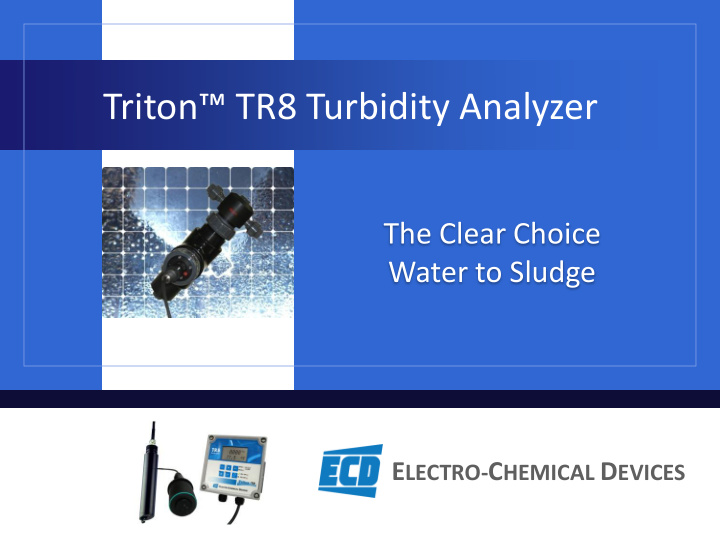



Triton™ TR8 Turbidity Analyzer The Clear Choice Water to Sludge E LECTRO- C HEMICAL D EVICES
What is Turbidity? Standard Methods for the Examination of Water and Wastewater describes Turbidity as “an expression of the optical property that causes light to be scattered and absorbed rather than transmitted in a straight line through the sample”. In simple terms, turbidity is the degree of cloudiness or haziness of a water sample caused by un-dissolved particles like silt, clay, emulsions or gas bubbles.
How is Turbidity Measured? Light Scattering The Degree Light is Scattered is Dependent on the Particle’s Size, Shape, Color and Refractive Index. Forward Scattering is very dependent on Particle size. Scattering at 90° is less Nephelometric Measurement dependent on Particle Detector size. Measurement of the light at 90° is referred to as Nephelometric.
How is Turbidity Measured? The TRITON™ TR8 Turbidity sensor uses the 1. LED (880 nm) Nephelometric method 2. Reference according to ISO 7027 / Detector 3. Short Path EN27027. Detector The TRITON™ TR8 has 4. Long Path three Detectors. Detector • A Reference detector to compensate for variations caused by aging or power fluctuations of the LED. 1. LED Emitter • A Short Path length 2. Short Path detector that is best for 3. Long Path higher ranges. 4. Wiper • A Long Path length detector that is best for lower ranges.
How is Turbidity Measured? The Long Path length detector measures Low level turbidity. Increasing the turbidity increases the number of particles and the intensity of the scattered light. 0 FNU 10,000 FNU Increasing FNU → Further increases start to Intensity vs. Turbidity block some of the scattered light and the intensity drops. Long Path Now there are two Short Path turbidity values for the same intensity value, oops!
How is Turbidity Measured? The Short Path length detector measures High level turbidity and has a different Intensity Profile. Comparing the two Path 0 FNU 10,000 FNU Increasing FNU → Length intensities allows Intensity vs. Turbidity the TRITON TR8 to determine the true turbidity value. Long Path This also provides a Short Path larger Measuring Range than most competitive analyzers.
How is Turbidity Measured? Measurement units • FNU : Formazine Nephelometric Unit NTU : Nephelometric • Turbidity Unit • FTU : Formazine Turbidity Unit • FNU = NTU = FTU 0.05 - 1 FNU 20-50 FNU The Standard Calibration for all three is with Formazine, 400 FNU Other Measurements • Grams per Liter, g/l • Parts Per Million, ppm • % Concentration, % 500-1000 FNU 6-10 g/l
What is the TRITON™ TR8 Complete Turbidity Analyzer System • Transmitter • Sensor • Installation Assemblies Two Separate Ranges • One Analyzer, Two Sensors • Clean Water (< 500 FNU) • Waste Water Units of Measure TR8 TR8- High FNU, FTU, NTU 0.000 – 9999 0.00 – 9999 ppm 0.00 – 3000 0.00 – 9999 grams/liter 0.0 – 3.0 0.0 – 300.0 % Concentration 0.0 – 200.0 0.0 – 200.0
TRITON™ TR8 Analyzer User Configurable Units of Measure: • FNU, FTU, NTU • ppm, g/l, % concentration • Temperature NEMA 4X Enclosure Choice of Power Supply • 115 VAC, 230 VAC or 24 VDC Single 0/4 -20 mA output, (optional 2 nd output) Single Alarm Relay (optional 2 or 4 additional 250 VAC, 30 VDC 2 amp relays)
TRITON™ TR8 Sensors Two Ranges (p/n 1398XXX-1 or -2) • The Standard is (-1 ) designed for Clean Water < 500 NTU • High Range (-2) water to sludge Choice of Cable Lengths • 7 meter • 15 meter With or Without Wiper Factory Calibrated (FNU, NTU) • Separately or with Flow Cell • Easy Calibration in 100%, 33% 10% dilution of the measured solution. Durable Sapphire windows • Easily cleaned with wet cloth G1 and ¾” MNPT threads
TR8 Sensor Specifications Measurement Principle • Nephelometric 90° NIR (880 nm) • ISO 7027/EN27027 Measurement Range • Standard: 0.000-500 FNU • High Range: to 9999 FNU Temperature Range • -5° - 50° C Pressure Range • 85 psig at 25° C • 15 psig at 50° C Accuracy • Maximum error < 5% of reading Repeatability • < 1% of reading
Installation Assemblies Immersion Assembly 1 meter (P/N 1000223) • De-bubbler Flow Cell • Optional 2” rail mounting brackets (P/N 2000278) Flow Thru Tee with Spray Cleaner Only available as a set • with the Sensor. Factory calibrated in Flow Cell. Flow Thru De-bubbler Flow Cell With • Only available as a set Spray Cleaner with sensor. Factory Calibrated in Flow Cell.
De-Bubbler Flow Assembly Gas Bubbles cause high readings, beware of: • Cold water warming up • Pressurized water going to atmospheric pressure • Water depressurized by Siphoning action out of the flow cell De-bubbler Assembly is a flow cell that provides a split stream bubble trap, eliminating bubbles from the measurement chamber
Where is Turbidity Used ? Waste Water Treatment • Primary Clarifier, Aeration, Secondary Clarifier, Sand Filter Break through and Backwash, Outfall • Activated Sludge, Sludge Thickening, Digesters Water Treatment • Incoming water, Filter Monitoring/Break through, Clear Well/Distribution. Rinsing Applications Dilution Applications
TRITON™ TR8 Features Factory Calibrated for Easy Start Up Dual Optical Pathways for Extended Range Internally Referenced LED for Stability Sapphire Windows Resist Scratching Optional wiper assembly with easily replaced rubber wipers Digital Signal for noise free Transmission up to 200 meters.
E LECTRO -C HEMICAL D EVICES Contact ECD For over 40 years Electro-Chemical Devices (ECD) has been a recognized leader in industrial process instrumentation: Liquid analytical sensors, controllers, transmitters, analyzers and electrodes. Electro-Chemical Devices Phone: +1-714-695-0051 +1-800-729-1333 1500 North Kellogg Dr Fax: +1-714-695-0057 Anaheim Ca 92807 email: sales@ecdi.com web: www.ecdi.com
Recommend
More recommend